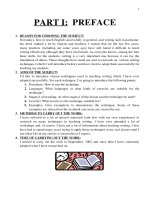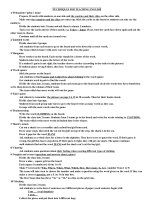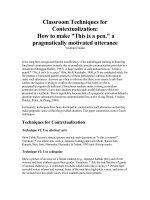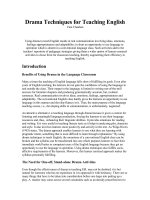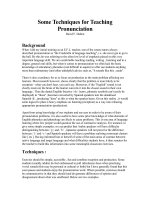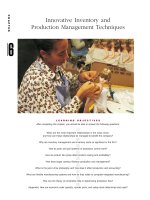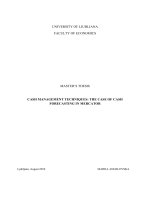Couture sewing techniques claire shaeffer
Bạn đang xem bản rút gọn của tài liệu. Xem và tải ngay bản đầy đủ của tài liệu tại đây (15.14 MB, 258 trang )
COUTURE
SEWING
Revised & Updated
ClaiRe B. shaeffeR
Techniques
COUTURE
SEWING
TechniquesREVISED & UPDATED
COUTURE
SEWING
Techniques
CLAIRE B. SHAEFFER
Text © 2011 by Claire B. Shaeffer
Illustrations © 2011 by The Taunton Press, Inc.
All rights reserved.
Pp
The Taunton Press, Inc., 63 South Main Street, PO Box 5506,
Newtown, CT 06470-5506
e-mail:
Editor: Erica Sanders-Foege
Copy editor: W. Anne Jones
Technical editor: Linda Conner Griepentrog
Indexer: Lynne Lipkind
Cover design: Kimberly Adis
Interior design/Layout: Kimberly Adis
Illustrators: Steve Buchanan and Christine Erikson
Cover photography: (front) Ken Howie, author’s Collection; (back, clockwise
from top) Ken Howie, author’s collection; Steven H. Bluttal, courtesy of the
Museum of the City of New York, Costume Collection. Costume worn by
Katharine Cornell in “No Time for Comedy” [1939] by S. N. Behrman; Photo
by Brian Sanderson, Courtesy of the FIDM Museum at the Fashion Institute
of Design & Merchandising, Los Angeles, CA. Gift of Mrs. Herbert Lawrence,
1956; Claire B. Shaeffer.
The following names/manufacturers appearing in Couture Sewing
Techniques are trademarks: Harper’s Bazaar
SM
, Mylar®, PlastDip®, Rigilene®,
Teflon®, Vogue Patterns®.
Library of Congress Cataloging-in-Publication Data
Shaeffer, Claire B.
Couture sewing techniques / Claire Shaeffer. Rev. and updated.
p. cm.
Summary: “Best-selling couture sewing reference that presents in clear
photos and illustrations and concise prose the basics and applications of
couture sewing, as well as its cultural importance” Provided by publisher.
E-Book ISBN 978-1-60085-835-2
1. Dressmaking. 2. Tailoring (Women’s) I. Title.
TT515.S483 2011
646.4 dc22
2011007172
Printed in the United States of America
10 9 8 7 6 5 4 3
❇
is book is dedicated to
home sewers everywhere who
appreciate fine workmanship
and take pleasure in creating
beautiful garments.
❇
Acknowledgments
couture houses, bespoke tailors, embroiderers,
and custom shirtmakers in Paris, Rome, London,
Florence, and New York.
Special thanks to the late Mme Marguérite Carré
for her personal memories of the techniques used
at Christian Dior, when she was the “première de
premières,” and to the late Charles Kleibacker for
sharing his knowledge of couture techniques.
For the 2nd Edition of Couture Sewing Techniques,
I thank Ralph Rucci and James Galanos for allowing
me to visit their workrooms, observe the techniques
which they used, and interview their employees. I am
grateful to the Fondation Pierre Bergé and Yves Saint
Laurent for arranging an interview with Jean-Pierre
Derbord, the premier of the atelier du tailler, who
shared his expertise and described the techniques
used at Yves Saint Laurent.
I am very grateful to Phyllis Magidson, the curator
at the Museum of the City of New York, with
whom I worked on a research project that focused
on Mainbocher and Charles Frederick Worth. is
project expanded my knowledge while reminding me
that many couture techniques which I had written
about earlier had changed little, if at all.
A special thanks to Ken Howie and Sherill Taylor,
who photographed the designs in my vintage
collection, and to their staffs and the stylists who
assisted them as well as the Phoenix Art Museum
and Neil’s of Palm Desert, who loaned mannequins.
I also want to thank the museums that loaned
photographs and sketches, their curators, and
photographers: Dennita Sewell at Phoenix Art
Museum, Phyllis Magidson at the Museum of the
City of New York, Gayle Strege at e Ohio State
University Historic Costume Collection, Valerie
Steele at the Fashion Institute of Technology, the
Metropolitan Museum of Art, Kevin Jones at the
Fashion Institute of Design and Merchandising in
Los Angeles, Söjic Phaff at Christian Dior, John
Wirchanski and the estate of Charles Kleibacker, and
Lynn Cook at Australian Stitches.
I want to thank Sarah Benson who helped with so
many things from typing and editing, making samples
and photos, organizing, repairing, and pressing the
garments to dressing mannequins.
I’m particularly grateful to e Taunton Press for
undertaking such a challenging project and to its staff,
especially my editor Erica Sanders-Foege, whose skills
and enthusiasm helped to transform my dreams into
reality.
And last, but not least, my thanks to my mother,
the late Juanita Sumner Brightwell, who taught
me that only my best was good enough, and to my
husband, Charlie Shaeffer, MD, whose support and
encouragement make it all possible.
A cannot be written without much help and
cooperation. I am greatly indebted to the couture industry, which helped
me enormously with the research for the original edition of Couture Sewing
Techniques. My thanks in particular go to the Chambre syndicale de la couture
parisienne, the governing body in Paris of the couture industry, and to the
106 pa rt t wo
Applying
Couture Techniques
108
C h a p t e r 6
Skirts & Pants
124
C h a p t e r 7
Blouses & Dresses
144
C h a p t e r 8
Sleeves
158
C h a p t e r 9
Pockets
172
C h a p t e r 1 0
Jackets & Coats
198
C h a p t e r 1 1
Designing
with Fabric
214
C h a p t e r 1 2
Special Occasions
240 Selected Glossary of Terms
243 Metric Equivalency Chart
244 Bibliography
247 Resources
248 Index
2
Introduction
4 pa r t o n e
The Basics
of Couture Sewing
6 C h a p t e r 1
Inside the World
of Haute Couture
24
C h a p t e r 2
The Art of
Hand Sewing
38
C h a p t e r 3
Shaping the Garment
66
C h a p t e r 4
Edge Finishes
86
C h a p t e r 5
Closures
2
haute couture will help you better understand
garment construction and fitting, and in turn, help
you to solve many problems you encounter.
My focus is on the craftsmanship, even though
elements like draping and design, proportion and
balance, fit and fabric are equally important. I’ve
concentrated on classic couture techniques that can
be applied to a variety of designs and fabrics and
also offer the most value to the greatest number of
readers.
e book itself is divided into two sections.
e first five chapters introduce you to the world
of haute couture, how it differs from expensive
ready-to-wear, basic couture skills, and essential
techniques. My instincts as a teacher compel me to
suggest that you read these chapters first.
e last seven chapters focus on the application
of these techniques to garments. e new chapter
—Chapter 11: Designing with Fabric—describes
particular details I’ve seen on specific fabrics.
Many of the photographs in the first edition were
no longer available so I’ve selected new ones from
various museums; and I’ve included photographs
of some garments in my vintage collection.
e measurements used throughout the book are
only guidelines; I suggest that you always purchase
extra fabric so you can make samples before sewing
the actual garment. is allows you to fine-tune the
dimensions and practice your skills.
No matter what your sewing expertise, this book
will expand your horizons. Most importantly, it
is a practical guide for learning the craft of haute
couture, and it will also provide new ideas for
applying the techniques that you already know.
While some techniques are less suitable for
beginners, most will be of value to the average
home-sewer; they are easy to duplicate and can be
applied to many designs and fabrics.
I find sewing by hand extremely rewarding. e
pleasure of both making and wearing beautifully
constructed garments far exceeds the time and
effort required to complete them. I hope this book
will help you develop these same skills and perfect
old ones, and, in turn, reward you with years of
pleasure—and a closet full of beautifully made
garments.
Introduction
I , . Very
few techniques are difficult, but they require time and patience. This
edition, like the original, describes couture techniques as practiced
in the ateliers of the haute couture. They are not adapted for home-
sewers because I feel strongly that grasping the principles used in the
3
I N T R O D U C T I O N
➤
P A R T O N E
This stunning two-piece dress
was made in the I. Magnin Custom
Salon in 1948 for Mrs. Moon, the
manager. Apparently influenced
by Christian Dior’s New Look
collection in 1947, this dress is a
very subtly designed border print
on silk muslin.
(Photo by Ken Howie. Author’s collection.)
e Basics
of Couture Sewing
1
Inside the World of
Haute Couture
W I P in January 1991 for a week of press
previews of the haute couture collections, the Gulf War had just begun
and the weather was brutally cold. Although I had visited the workrooms
of many couture houses over the years, this would be the first time I would
have the opportunity to attend the runway shows debuting their collections,
and I did not know what to expect. I soon found that
each show was as different from the next as the designs it
presented. All were extravagant and exhilarating to watch.
e designs themselves were magnificent, although some
were so flamboyant that it seemed they were not really
intended to be worn off the runway. Many, however,
would set the next season’s fashion trends. Literally
translated, the French phrase haute couture means
“sewing at a high level,” but a better translation might
be the “finest high-fashion sewing.” Although the haute
couture designs shown on runways in Paris and Rome
are too expensive for most pocketbooks, their influence
on styles, colors, and accessories echoes throughout the
women’s clothing industry worldwide. For the home-
sewer, haute couture designs have a special relevance.
Inspired by a Guy Laroche
dress, the author designed this
evening gown for Vogue Patterns.
Fabricated in an unusual satin/
wool brocade, the dress is cut on
the bias. It has a single seam at
center back with darts positioned
vertically and horizontally to
enhance the figure. The muslin
toile, or working pattern, at
the right was used to refine
the fit and determine the best
construction techniques.
(Photo by Ken Howie. Author’s collection.)
8
T H E B A S I C S O F C O U T U R E S E W I N G
Custom-sewn for a select group of women who can
afford them, couture garments are simply the most
beautifully made in the world. It may surprise some
to learn that most of the techniques used in couture
workrooms can be duplicated at home.
Originating in mid-19th-century Paris with the
designs of an Englishman named Charles Frederick
Worth (see “A Brief History of Couture” on p. 12),
haute couture represents an archaic tradition of
creating garments by hand with painstaking care
and precision. In an elaborate process that’s very
much the same today as it was in the 1850s, each
couture garment is custom cut, fitted, and even
frequently redesigned for a particular individual.
e process involves numerous steps and people
with specialized skills, from the couturier, or designer,
who creates the design to the team of assistants,
fitters, and needleworkers who bring it to life.
Today, even though there are excellent couturiers
in Rome, the center of haute couture remains in
Paris, where there is still an enormous support
structure of skilled workshops and needleworkers
who specialize in hand embroidery, beading,
feather work, braiding, fabric flowers, and custom-
made accessories. In France, the term haute couture
is strictly controlled by the Chambre syndicale
de la couture parisienne (Parisian High Fashion
Syndicate), the governing body of French fashion
houses. e use of this term is reserved exclusively
for the group’s eleven members, who meet the
strict qualifying rules outlined below. e official
list for haute couture spring/summer 2010 for
members included Adeline André, Anne Valérie
Hash, Chanel, Christian Dior, Christian Lacroix,
Dominique Sirop, Franck Sorbier, Givenchy, Jean
Paul Gaultier, Maurizio Galante, and Stéphane
Rolland. ere are also five Correspondent
(foreign) Members including Elie Saab, Giorgio
Armani, Maison Martin, Margiela, and Valentino
as well as 14 Guest Members. Two Americans—
Mainbocher and Ralph Rucci—are former
members; Oscar de la Renta was the couturier for
Pierre Balmain. To be named to the list remains
the highest recognition that a designer can achieve.
To earn the right to call itself a couture house and
use the term “haute couture” in its advertising or in
any other way, a member of the Chambre syndicale
must design fashions that are made to order for
private clients and involve one or more fittings,
have a workroom in Paris with at least 15 full-time
workers, present a collection of at least 35 designs,
including day and evening garments, to the press
in Paris in January for spring/summer season and
in July for the autumn/winter season, and show
the collection to potential clients in the respective
couture houses.
e Chambre syndicale’s definition of a couture
house is so limiting that it excludes such notables
as the houses of Renato Balestra, Gattinoni
Couture, Romeo Gigli, and Sarli Couture, who
both work and show their collections in Italy. Even
Deceptively simple, this timeless design features pin-
tucking on the cashmere knit.
(Photo by Ken Howie, courtesy of Chado Ralph Rucci and the Phoenix Art
Museum.)
9
I N S I D E T H E W O R L D O F H A U T E C O U T U R E
the many old, established French couture houses
do not qualify because, although their workrooms
are in Paris, they do not present a collection.
What makes couture “haute”?
What’s so special about haute couture designs
that simple day dresses range in price from $8,000
to $20,000, suits from $10,000 to $50,000,
and evening gowns from $15,000 to as much as
$500,000? ere are many factors, notably the
fabulous, exclusive fabrics used, the flawless design,
cut and fit of each garment, the exquisite
craftsmanship, and the time required.
Haute couture begins with strong, innovative
design—the couturier’s ability to interpret the
mood of the time for the mode of the world.
Whether classically styled or exaggerated, couture
designs rely on such basic design principles as
proportion, balance, color, and texture, and they
conform to the image of the couture house.
Maintaining the integrity of a design while
making adjustments to suit a client’s figure and
personal preferences is a delicate balancing act.
Most couture houses will go to great lengths to do
both. Several years ago, for example, when I visited
the workrooms of English designer Hardy Amies,
the staff had just fitted a client’s dress, which she
felt was about 1 in. too short. e black velvet,
asymmetrical design featured a 4-in. pleated taffeta
ruffle inserted in a seamline that began at the left
shoulder, curved gently downward and ended at
the right side seam about 4 in.—a ruffle’s width—
above the hemline. Since the garment had a wide
hem allowance, it could have been lengthened by
simply lowering the hem, but then the proportion
of the ruffle’s width and distance to the hemline
would have been spoiled. Rather than demean the
design, the house decided to lower the seamline,
even though it meant cutting a new right front that
positioned the ruffle precisely 4 in. above the hem.
Couture designs are enhanced by the
extraordinary fabrics from which they are sewn.
Only the finest luxury fabrics are used in couture,
and they frequently cost hundreds of dollars a yd.—
some cost more than a thousand dollars a yd. Most
fabrics are made of natural fibers, but they can be
made of silver threads; and a few couturiers use
metallic, plastic, and man-made fibers for special
effects. In the 1960s, designers experimented with
new materials like Mylar
®
. See Chapter 12, p. 214,
for a Mylar dress designed by Chanel.
Designs by Balenciaga, Yves Saint Laurent, and
Givenchy have what initially appears to be an
unnecessary use of an expensive fashion fabric
for the lining or backing. When examined closely,
The only American designer to have an eponymous
couture house in Paris, Main Bocher changed his name
to Mainbocher and gave it a French pronunciation. This
boned-strapless gown was considered old-fashioned in
1934 when Mainbocher created it.
(Photo by David Arky, courtesy of the Museum of the City of New York, gift of the
Estate of Tilly Losch, Lady Carnarvon, ca. 1956.)
10
T H E B A S I C S O F C O U T U R E S E W I N G
it is apparent that there was a reason for the
extravagance. e two most common reasons are
to eliminate a hem at the lower edge and to provide
an inconspicuous lining fabric that might show
when the garment is worn. My favorite is a short,
special occasion dress by YSL. On the outside,
the skirt has pleats at the waist; on the inside, the
same fabric is tucked under the pleats to provide
support. ere is only a fold at the hemline.
Many printed fabrics are made with exclusive
patterns or colorways, meaning the same design in
different colors, designed by either the couturier
or a fabric designer. A few couturiers work closely
with a fabric house to develop new fabrics. Some
fabrics, such as the extra-wide silks manufactured
for Vionnet, the silk gazar designed in 1958 for
Balenciaga by the noted fabric-design firm of
Abraham (see below) and the printed silk muslin
designed in 1947 for Dior by the firm of Bianchini-
Ferier (see the photo in Chapter 12 on p. 220), are
still widely used. Many other original fabrics are, of
course, no longer available.
e long-standing liaison between the House
of Chanel and the fabric firm of Linton Tweeds
began with Chanel’s first collection in 1919 and
continues today. Frequently used for Chanel suits,
Linton fabrics are often a combination of wool and
mohair, but many incorporate acrylic, metallics,
novelty yarns, and even cellophane. e House of
Chanel chooses from 15 to 40 exclusive patterns
for the firm of Linton to weave in lengths of
small amounts of 6 to 8 meters so they can make
prototype designs for the runway. Linton will also
weave fancy selvages, which might include the more
expensive yarns in the fabric and supply matching
yarns and narrow trims when requested.
The ”Swan” ball gown from 1954, like many others by
Charles James, is heavily boned with a lowered back
waist. As is typical for a couture design, the dress
was made to fit its owner and cannot be altered
successfully for another individual.
(Photo courtesy of Chicago History Museum, gift of Mrs. Corson Ellis.)
Designed by Cristobal
Balenciaga in the
1950s, the simple lines
of this coat showcase
the unusual fabric,
which appears to be
gazar woven like a
matelassé. The coat is
completely lined with
self-fabric even though
it most certainly added
to the cost.
(Photo by Taylor Sherrill.
Author’s collection.)
11
I N S I D E T H E W O R L D O F H A U T E C O U T U R E
e Atelier
In the atelier, or workroom, of a couture house,
fabric patterns are sometimes cut apart, rearranged,
and sewn back together to create special effects
for a particular design (for example, see the blouse
by Chanel on p. 208). is procedure is most
often used to rearrange the color bars on striped
fabrics or to appliqué motifs where there is a void
on the garment, but I’ve seen fabrics that were
literally created in the atelier. Some are relatively
simple creations—such as the red-and-blue-
striped Chanel blouse I saw that was made by
cutting red and blue fabrics into narrow strips and
seaming them together. Others, such as the fabric
customized in Valentino’s atelier for a wedding
gown, are extremely labor intensive. at particular
fabric had pink-and-white-ruffled diamond
patterns completely covering the gown’s tulle skirt,
which took four workers four weeks to make.
Buttons and trims are often custom-made as
well. Braids run the gamut from silver crocheted
trims to re-embroidered braids to thread-
wrapped embroidered topstitching. Buttons
range from Worth’s fabric covered buttons with
an embroidered flower on top to Schiaparelli’s
avant-garde, whimsical designs with plastic cicadas
or ceramic trapeze artists to Chanel’s simpler
double-C gilt designs or ornate camellia buttons.
In addition to the array of high-quality trims
employed on a couture garment, the fit is also a
highly conceived element of any couture piece.
A couture garment fits flawlessly as a result of
multiple fittings on the client’s dress form, which
has been customized to duplicate her figure, but
more impressive than the fit are the subtle ways in
which a couture garment is proportioned for the
individual client. For an asymmetrical figure, for
example, the collar, pockets, and shoulder seam
may be slightly narrower on one side. For a full
figure, vertical seamlines are moved in or out as
needed to create the most flattering line, while for
a short figure, all horizontal seamlines are adjusted,
not just the waistline and hem.
e size of the client’s garment also affects
the way it is embellished. On a garment with
embroidery or beading, the embellished design is
scaled to the dimensions of the client’s garment, so
that it does not overwhelm a smaller figure or float
against the sizable background on a larger one.
Craftsmanship
Impeccable craftsmanship is the essence of haute
couture, and it begins long before the fabric is
cut. With the help of a muslin pattern, or toile,
every design is planned so the motifs, stripes, or
plaids are not only matched, but also positioned
most attractively for the client’s figure. At garment
openings, floral motifs match so perfectly you have
The legendary designer Christian Dior drapes silk
taffeta on a model to begin a design for his 1948
collection. According to Mme. Marguerite, who worked
closely with him, he would then make quick sketches
from which the atelier premiers would cut and sew the
first toile.
(Photo by Bellini, courtesy of Christian Dior.)
continued on p. 17
12
T H E B A S I C S O F C O U T U R E S E W I N G
IN THE BEGINNING, FRANCE
was recognized as the world’s
foremost fashion leader when
Louis Napoleon Bonaparte
established the Second Empire
in 1852. About the same
time, an Englishman named
Charles Frederick Worth, a
sales assistant at the famous
Parisian fabric store, Gagelin-
Opigez et Cie., persuaded his
employers to allow him to open
a new department with a few
dressmakers. By combining his
extensive knowledge of fabrics
and garment construction with
a talent for promotion, Worth
soon established himself as the
A Brief History of Haute Couture
only male dressmaker in Paris.
Worth executed each of his
original designs in several Gagelin
fabrics, distinguishing himself
from conventional dressmakers,
well-trained technicians who
combined the customer’s
design and fabric. In so doing,
he became the father of haute
couture, a phrase coined in 1863
by an American client, a Mrs.
Moulton.
THE HOUSE OF WORTH
In 1858, Worth created his own
couture house with his partner
Gustof Bobergh. Within two years,
he secured the patronage of the
French Empress Eugénie, one
of the most important fashion
leaders of all time. Worth was the
first to establish a house style and
create a collection of seasonal
designs shown on live models.
In 1868, Worth established the
Chambre syndicale de la couture
parisienne, the governing body of
French fashion.
Worth was also the first to
understand the relationship of
the fabric to the design. He began
cutting garment sections with
the grain and used one of the
concepts of mass production—
interchangeable, modular parts—
to create a variety of different
designs. But the fashion change
he made that pleased him most
was abolishing the “cage,” or hoop
skirt, in favor of a more relaxed
silhouette.
When the Franco-Prussian War
toppled the Second Empire in
1870, the fairy tale ended, and
Worth lost his most important
client when Empress Eugénie
went into exile. Paris, nonetheless,
continued as the international
center of high fashion—albeit
more restrained fashion—and
Worth continued to design for
women of wealth and note.
At the same time, aesthetic
dress, which was initially inspired
by designs from late medieval
and early renaissance periods,
was introduced. These soft, loose
dresses were simply embellished
and worn without a corset. The
aesthetic movement reached its
height in the 1880s.
THE BELLE EPOQUE
As La Belle Epoque dawned, the
first important woman designer,
Madame Pacquin, founded her
couture house in 1891. Although
she became known for glamorous
evening gowns, exquisite work-
manship and innovative mix of
materials, Pacquin was also a
practical designer. She introduced
a dress style tailored enough for
daywear but elegant enough for
informal evening occasions. She
was the first French designer to
Designed by Jeanne Pacquin, this
silk velvet and satin gown illustrates
the designer’s talent for creating
an afternoon dress that could be
worn to dinner.
(Courtesy of Chicago History Museum.)
13
I N S I D E T H E W O R L D O F H A U T E C O U T U R E
publicize her designs by sending
several models to the races at
Longchamps wearing the same
outfit, and she was the first to
open international branches of
her couture house.
CHANGING TIMES
When the new century dawned,
women were still confined in tightly
laced corsets and elaborately
ornamented clothing, but the
fashion world was ready for a
change. Credited with modernizing
dress design, Paul Poiret intro-
duced the straight silhouette in
1907, which has dominated fashion
for most of the century. Worn with
a less confining corset, the fore-
runner of the brassiere, his new
design—the shift—was a simple
narrow tube with a high waist.
The first couturier to collaborate
with artists such as Raoul Dufy,
Poiret produced new fashions
that were bold, brilliantly colored
and exotic, and were often
distinguished more by their
decoration than by their cut.
Madeleine Vionnet, another
innovative designer, showed her
radical new designs in 1907 while
working for French couturier
Jacques Doucet, one of the major
competitors of the House of
Worth at the turn of the century.
Cut entirely on the bias and
worn over uncorseted figures,
Vionnet’s dresses appeared
simple in design, but their
construction was quite complex.
Mass production of various
goods began during the war, and
many women entered the work
force. Even though clients from
the Austrian, German, Balkan, and
Russian courts had vanished, the
couture houses thrived after the
war. They created simpler, less
individualized designs intended
for wealthy, fashionable women
in France and abroad, but most
sales were now made to retailers,
who purchased hundreds of
models or to manufacturers who
planned to copy them. As a result,
many couture houses became
specialists in handmade designs.
During the 1920s, the
“garçonne,” or boyish look,
became popular, introducing
a new informality to the haute
couture fashion scene, which
was dominated by Jean Patou
Known for superb workmanship, intricate cuts, lace, and embroidered
embellishments, the atelier Callot Sœurs specialized in formal eveningwear.
(Photo by Steven H. Bluttal, courtesy of the Museum of the City of New York, gift of Mrs. Robert L. Stevens &
Mrs. Cornelius Vanderbilt.)
14
T H E B A S I C S O F C O U T U R E S E W I N G
which could be imported to
America duty free.
In the 1930s, fashions changed
dramatically once more. Italian-
born designer Elsa Schiaparelli
created outlandish fashions
in unique color combinations.
Known for her hard-edge chic
and fantasy, “la Schiap” created
styles that often featured prints
and embellishments designed
by such artists as Dali and
Cocteau. She is credited with
inventing the long dinner suit and
voluminous evening trousers.
Inspired by masculine uniforms,
she introduced the broad-
shouldered, boxy silhouette that
dominated fashion from 1933 to
the late 1940s.
After Germany invaded
France in 1940, many couture
houses closed, while others
moved—Molyneux to London
and Mainbocher to America—but
most continued to present small
collections.
During the war years, American
designers like Gilbert Adrian,
Irene, Jean Louis, Charles James,
Valentina, Claire McCardell,
Mainbocher, Norman Norell,
Hattie Carnegie, and Sophie
Gimbel developed an American
style. Intended for a more
active lifestyle, this style was
straightforward and more
youthful than the European
tradition on which it was built.
THE NEW LOOK
Women’s fashions remained
virtually unchanged after the war
until Christian Dior showed his
first collection in 1947. Dubbed a
“New Look” by Carmel Snow,
editor of Harper’s Bazaar
SM
maga-
zine, Dior’s designs featured long,
full skirts, wasp waists, and narrow
sloping shoulders. Influenced by
La Belle Epoque, Dior restored
femininity to a world tired of uni-
forms and uniformity and made
fashion exciting once more. The
couture industry was revitalized.
During the postwar boom and
into the 1950s, haute couture
continued to flourish. Pierre
Balmain created magnificent ball
gowns, Jacques Fath introduced
This avant-garde Poiret ensemble
is from about 1919. The coat is
fabricated in a single layer of wool
double cloth. Wool inserts conceal
seaming on the face of the coat.
(Photo by Steven H. Bluttal, courtesy of the Museum
of the City of New York, gift of Mrs. Henry Clews.)
and Coco Chanel. Inspired by
sportswear, Patou invented the
V-neck sweater and the short
pleated skirt, and was the first to
use his monogram as a design
element. Chanel put her rich
clients, who had been wearing
satin and lace day dresses, into
casual, unstructured jersey
dresses and woolen cardigan
jackets.
The 1929 Wall Street crash
abruptly ended the prosperous
Roaring Twenties. When the
United States raised import taxes
on couture designs, many houses
began selling designs and toiles
to retailers and manufacturers,
Cut on the bias, this asymmetrical
Vionnet design from 1922 is fabri-
cated in multiple layers of silk crepe
georgette and trimmed with lamé.
(Photo by Ken Howie, courtesy of the Phoenix Art
Museum, gift of the Arizona Costume Institute in
honor of the Museum’s 50th anniversary, 2009.)
15
I N S I D E T H E W O R L D O F H A U T E C O U T U R E
later combined with fashion and
fabric developments in the 1960s,
would have a devastating effect
on haute couture.
By the mid-1960s, couture
fashions were less structured
and even more casual, inspired
by the loose-fitting fashions of
the hippie movement. With the
demise of the bra and fitted
silhouettes, the fashions coming
out of Paris were easily copied in
all price ranges. For the first time
in history, couture had lost its
leading edge, and many couture
pastels to bridal wear, and
Hubert de Givenchy introduced
separates to high fashion. In the
early 1950s, an unfitted silhouette
was ushered in with Cristobal
Balenciaga’s introduction of the
sack dress in 1951. By the mid-
1950s, many designers were
showing designs that bypassed
the waist. Notable was Yves
Saint Laurent’s trapeze dress,
created for his first collection
at Dior in 1958. The new relaxed
silhouette was off and running
but, unfortunately, its success,
houses launched prêt-a-porter, or
luxury ready-to-wear, collections.
Pierre Cardin, the first to do so
in 1959, was promptly, though
temporarily, expelled from the
Chambre syndicale.
By 1975, luxury ready-to-wear
was an important industry.
Unfortunately, the success of
the new luxury ready-to-wear
clothing came at the expense
of haute couture fashions. The
easy availability of luxury ready-
to-wear meant that retailers and
manufacturers no longer had to
purchase toiles and designs for
copying.
The “Me” Decade
Dubbed the “Me Decade” by
writer Tom Wolfe, the 1970s
offered many choices. Fashions
were romantic, individualistic, and
unstructured, with extravagant
interpretations of Russian,
Chinese, African, Indian, and
gypsy themes, as well as “retro”
looks from the 1920s, ’30s,
and ’40s. The decade, too, was
dominated by pants—from very
short hot pants, stovepipes,
and bell-bottoms to Yves Saint
Laurent’s trouser suit for women.
The Big ’80s
With the 1980s came an English
royal wedding, an infusion of
Middle Eastern petrol dollars, the
ostentatious Reagan Era, and
new clients from Japan. There
was lots of new money, younger
customers, and a renewed
The ”Petal” ballgown was constructed like many Charles James designs
with a boned bodice and elaborate skirt. Fabricated in black velvet and silk
taffeta, the skirt has numerous underskirts, all cut in different shapes, to
support the approximately 25 yd. of fabric in the overskirt.
(Photo by Ken Howie, courtesy of Phoenix Art Museum, gift of Mrs. Eleanor Searle Whitney McCollum, 1975.)
16
T H E B A S I C S O F C O U T U R E S E W I N G
interest in haute couture. Karl
Lagerfeld was hired to modernize
the Chanel style and resuscitate
the couture house. The innovative
Christian Lacroix revived the
House of Patou and promptly
left to establish his own label,
putting us all in pouf dresses.
Yves Saint Laurent perfected
his classic styles for day and
rich fantasies for evening, Pierre
Cardin continued to develop
his geometric-inspired futurist
shapes, and Givenchy and
Valentino created the elegant
luxuries their clients adore.
COUTURE TODAY
The finest jewel in fashion’s
crown, haute couture is an
anachronism today. Having
peaked in the 1940s and 1950s,
when its sales were the major
source of income for the great
design houses, couture clothing
has largely been replaced by
luxury ready-to-wear, which
is generally called couture in
America. Couture sales have
dropped to a fraction of their
all-time high. The couture
customer base has dwindled to
an estimated 2,000 with perhaps
only a few hundred women
purchasing regularly, and the
number of couture houses has
dropped from a high of 53 after
World War II to 21 at the beginning
of 1993. By 2010, there were just
11. Given the shrinking clientele
and rising prices of haute
couture, it’s not surprising that
its future is frequently a subject
for speculation. Many couture
houses such as Givenchy, Ungaro,
and Balmain have discontinued
their haute couture collections.
Today, couture is considered
the engine that pulls the train as
the most successful houses spin
off lucrative licenses for ready-
to-wear clothing, fragrances,
cosmetics, fashion and home
accessories, chocolates and even
automobile interiors. The House
of Cardin, for example, had
840 licenses in 94 countries,
including one for car tires.
Although supported by bigger
and more profitable business
operations, haute couture is
still an art form practiced by a
few creative men and women
and a small group of skilled
artisans. Whether classic in
style or playfully outrageous,
the designs that emerge from
couture workrooms influence
women’s fashions throughout the
industrialized world.
Ralph Rucci is the master of simple,
modern silhouettes that belie their
complexity. This design, from his 2010
collection, features a bias-cut satin
slip and sweater with bugle beads.
(Photo courtesy of Chado Ralph Rucci.)
In 1959, Pierre Cardin was banished
from the
Chambre Syndicale
because he introduced a ready-
to-wear collection. After his
reinstatement, his sculptured
space-age designs set the fashion
trends for several years. This dress
from 1965 is fabricated in a thick
wool double knit.
(Photo by Ken Howie, courtesy of the Phoenix Art
Museum, Donor Mrs. Peter Lipton.)
17
I N S I D E T H E W O R L D O F H A U T E C O U T U R E
to look twice to see the fasteners, and on suits and
two-piece designs, the fabric pattern continues
uninterrupted from neck to hem.
During the construction process, most of the
sewing is done by hand. ousands of perfectly
spaced basting stitches mark or hold the garment
layers together temporarily so a design can be
fitted on the client or dress form, stitched or hand-
sewn permanently or precisely pressed. en
these stitches are taken out so the construction
can continue. Again and again, the fabric is
painstakingly shaped and manipulated in the
hands or on a form until the garment is completed.
Even the seams may be permanently sewn by hand.
e construction of the dress, gown or suit that
emerges may look effortless, but it takes many
hours to produce that effortless look.
All of the hand sewing that goes into making a
couture garment distinguishes it from a comparable
design in luxury ready-to-wear, which is known
in France as prêt-à-porter. Priced from $200 for
a cotton shirt, for example, to $30,000 for an
evening gown, luxury ready-to-wear is sewn from
high-quality fabrics and sold in better stores and
boutiques all over the world. Hundreds of copies
of each design are sewn, primarily by machine
operators, who are part of a piecework system—
each one performs the same operation over and
over. As a result, there’s considerably less hand
work on many luxury ready-to-wear garments
by such designers as Armani, Ralph Lauren,
Oscar de la Renta, or Versace. e garments are
nonetheless lovely, and most are clean-finished, or
lined with rayon or silk to conceal serged, pinked,
or unfinished seams.
Creating a Couture Collection
Twice a year, in January and July, each couture
house spends millions of dollars to present its
collections. Although the couture shows were once
sedate affairs held in couture salons, they have
become theatrical extravaganzas produced with
lights and loud music. Designed to lure almost
1,500 members of the media to Paris, the shows
generate important publicity for the designers. e
most successful designs that make headlines in
January and July are eventually copied or translated
into mass-produced clothing in all price ranges.
As a laboratory for women’s fashions, the couture
industry has a major impact on what women wear.
A couture collection is frequently developed
around a theme such as a major art exhibit, an
exotic vacation spot, or a period in fashion history.
e collection will have some day dresses, some
suits (and occasionally trouser suits), a few short
evening designs, and a number of long gowns.
Some designs will be comfortable and may flatter
older or less-than-perfect figures. Others may
include a few glitzy showstoppers to promote the
house’s image and excite the press.
Designing the
Couture Collection
e first phase of assembling a collection begins
in the couturier’s design studio many months
before the press show. e couturier will begin
with either the fabric or the silhouette. ey must
be compatible because the combined qualities of
the fabric, that is, its weight, drape, texture, and
hand (the fabric’s crispness or softness), will make
it appropriate for some types of silhouettes and
not for others. If the designer is contemplating an
exaggerated, sculpted look, a crisp, tightly woven
fabric will probably be chosen. If, on the other
Designed by Christian Dior,
this sketch of ”Mexico” for
Summer 1953 is called a
croquis. A photograph of the
design is shown on p. 220.
(Photo courtesy of Christian Dior.)
18
T H E B A S I C S O F C O U T U R E S E W I N G
hand, the designer begins with a bolt of soft fabric,
the design will probably fall more gently and follow
the lines of the body. One designer known for his
ability to use a fabric to its fullest potential was
the Spaniard Cristobal Balenciaga (see one of his
designs on p. 10).
When the fabrics arrive, the couturier drapes
unfolded lengths of each one over a dress form or a
model to see how it hangs on the lengthwise grain,
crossgrain, and bias. en, using this information
as a guide, he makes hundreds of croquis, or design
sketches, for his collection. Since it is impossible to
develop toiles for every sketch, the editing process
to select the best designs and fine-tune the focus of
the collection begins at once. is is usually done
by the couturier with the help of design assistants
and the premières, the heads of the ateliers, whose
technical expertise is highly regarded. e design
sketches are then distributed to the workrooms.
Tailoring Workrooms
Depending on the type of garment the couturier
has designed, his sketch will go to the atelier du
tailleur (tailoring workroom) or to the atelier du
flou (dressmaking workroom). e garments made
in the tailoring workroom are more structured
than those created in the dressmaking workroom,
and the tailoring fabrics, usually woolens, tend to
be heavier than dressmaker fabrics. In the tailoring
workroom, the fabric is often shaped by stretching
and shrinking it (see p. 64) and is supported by the
garment’s entoilage, or inner structure of
interfacings and pad stitching.
A few houses have two tailoring workrooms: one
that concentrates on tailored, menswear-influenced
designs made of fabrics similar in texture, weave, and
weight to those used for menswear; and a second
that concentrates on softer dressmaker styles made
of soft wools, mohairs, bouclés, or chenilles.
In the dressmaking atelier, where many gowns,
dresses, blouses, and other garments are sewn, silk
is the predominant fabric. Many of the garments
made in this workroom are softly draped designs
that have to be sewn on a dress form from the
right side of the garment in order for the draped
folds of the design to be accurately pinned and
stitched in place. Some designs have no inner
structure and rely completely on the body to give
them shape (see the bias-cut dress designed by
Madeleine Vionnet, shown on p. 14). Others, like
the Charles James gown (see p. 15), may be backed
or rely on an elaborate inner structure.
After discussing the design with the couturier,
the première decides who will make the toiles and
sew the prototypes, called modèles. e toiles and
prototypes are usually sewn by the premières mains
or “first hands,” who are the most experienced
workers in the atelier, and a small group of workers,
or mains (“hands”), with a variety of skills and
training. en a muslin fabric in the appropriate
weight for the design is selected, and the toile is
draped on a dress form to duplicate the couturier’s
sketch and provide the basic pattern from which
the garment will be sewn. Depending on the
complexity of the design, this process usually takes
four to eight hours.
Even though the toile is just a working pattern, it
is made carefully with the necessary underpinnings
and sometimes even with buttonholes. During
its development, the toile is basted and rebasted
for fittings on one of the house models and is
examined and modified again and again until the
couturier is satisfied.
In the New York
workroom at Scaasi,
this dressmaker is
basting the hem.
Notice that the bulk
of the garment is
supported on the table
and she is holding a
small section of the
hem in her hand.
(Photo by Author.)
